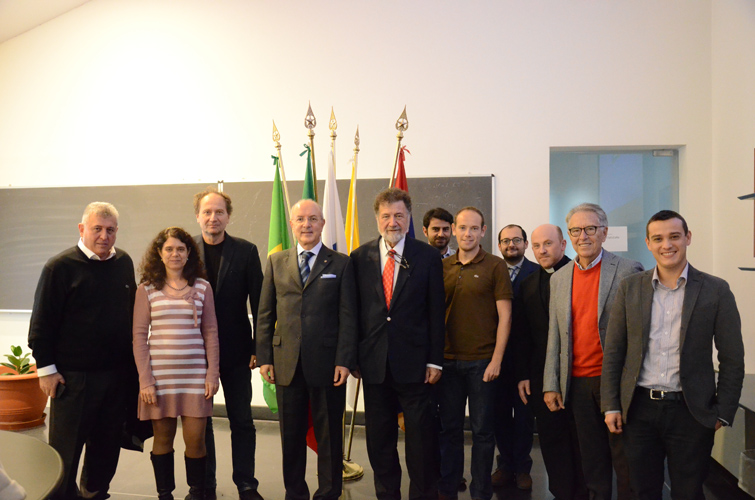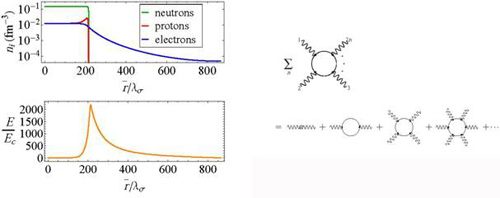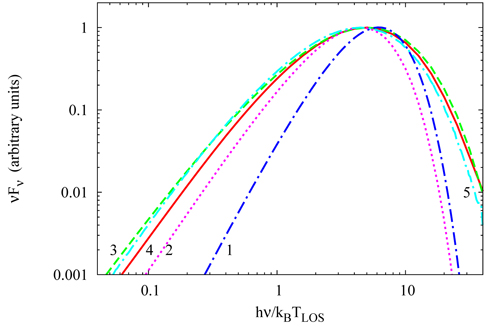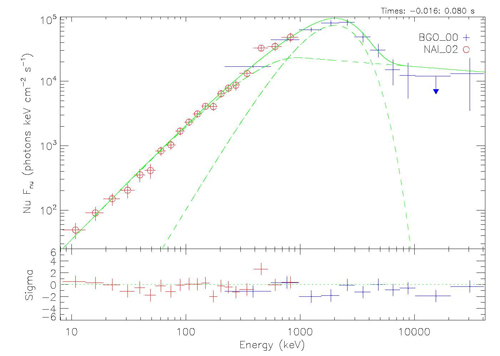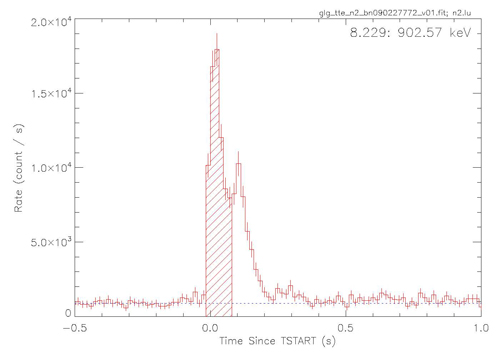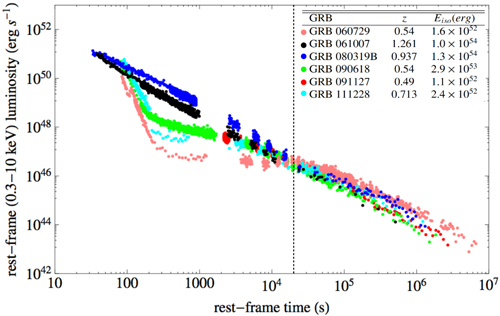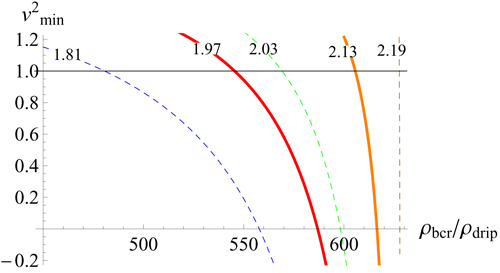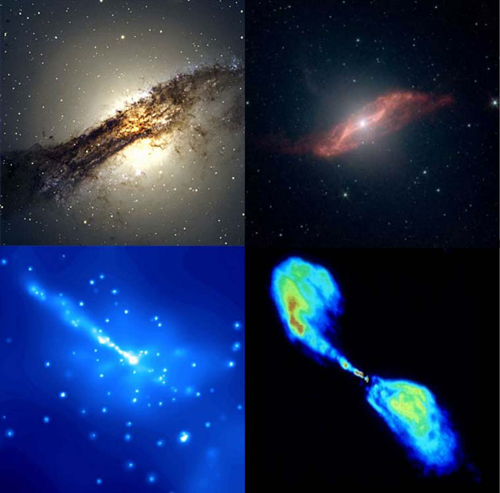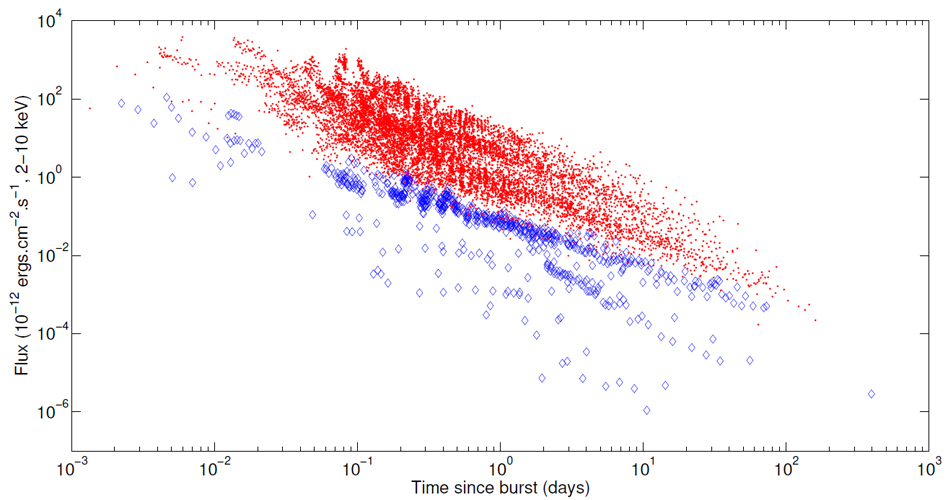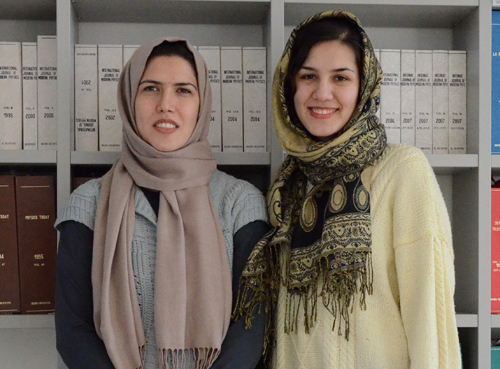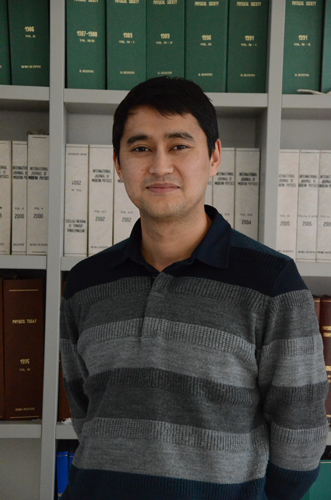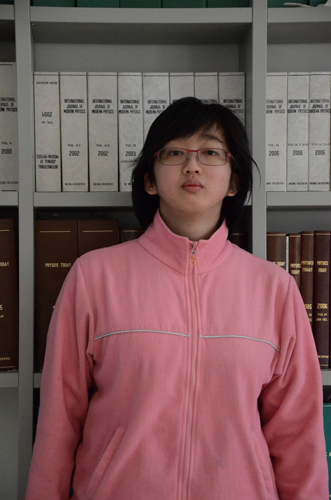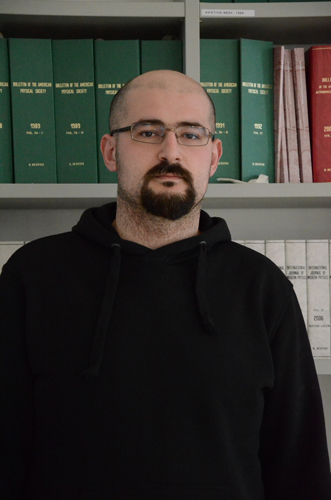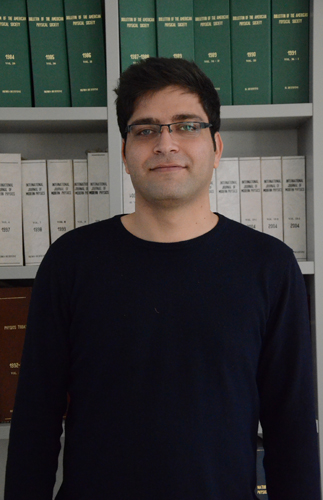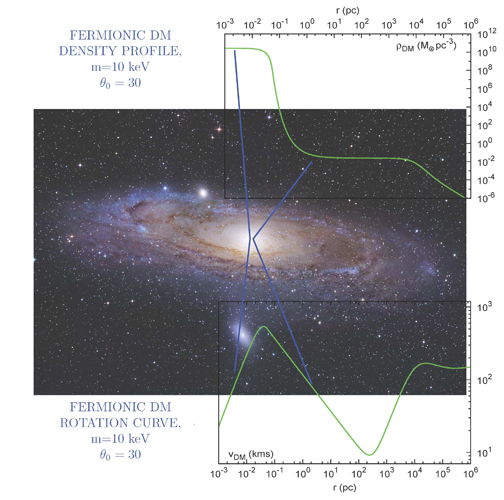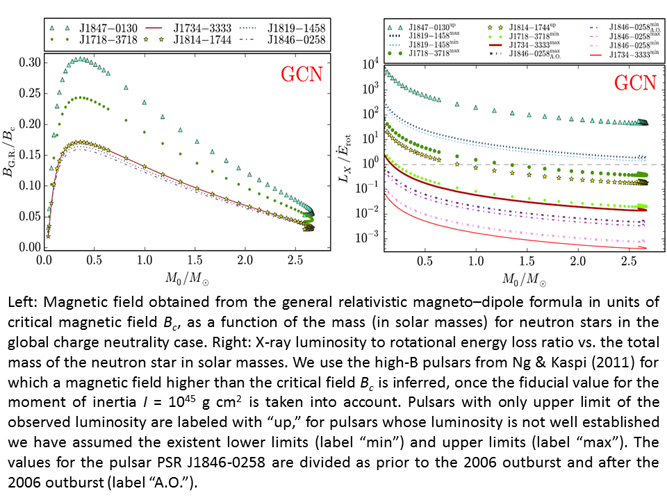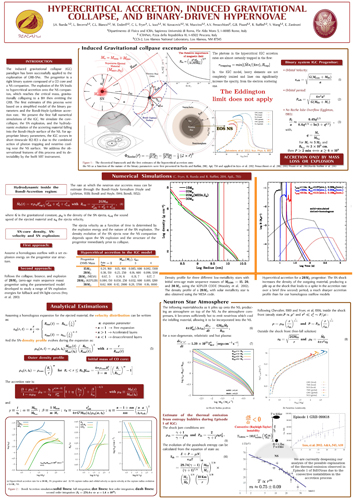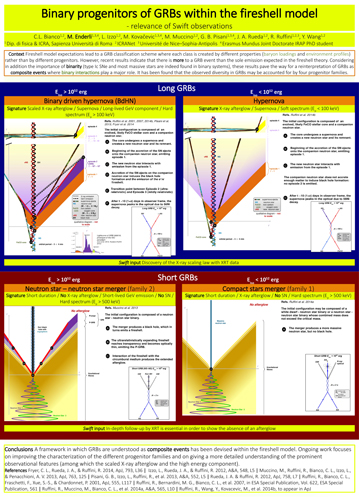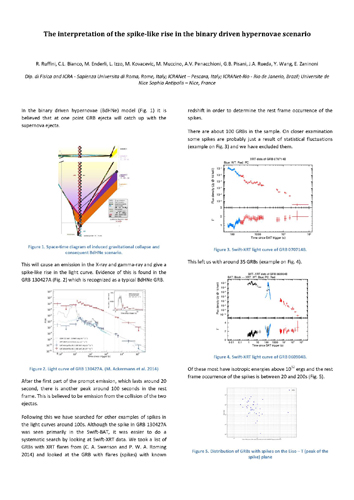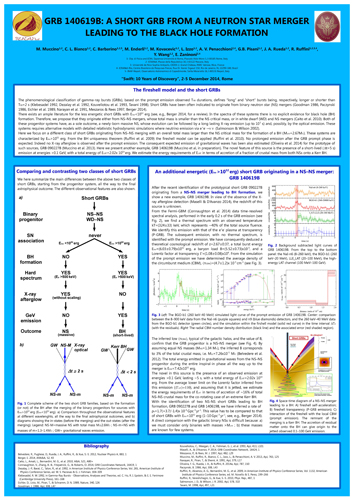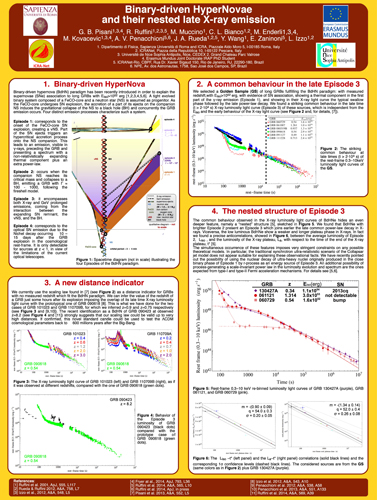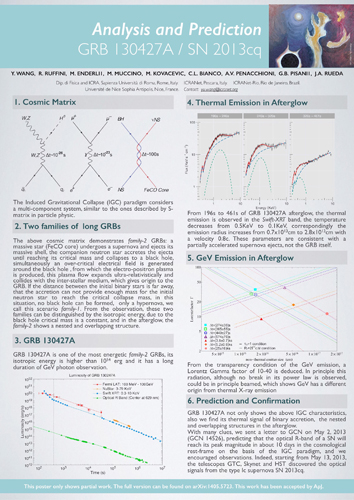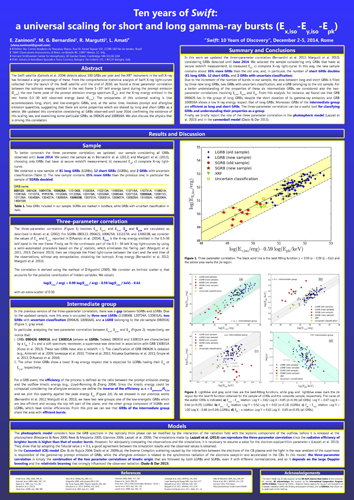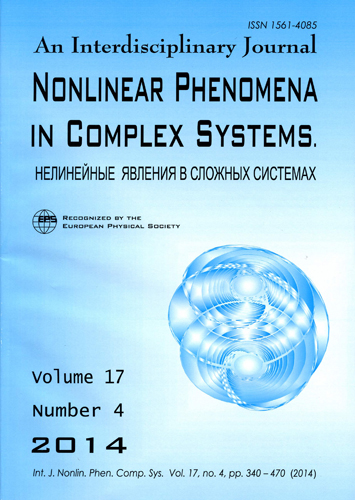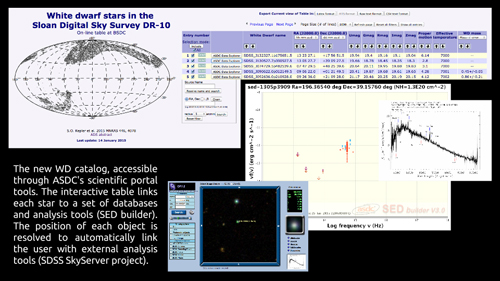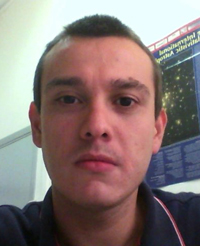

| Newsletter Armenian November/January |

|

|





ICRANet Newsletter
ICRANet Newsletter
Նոյեմբեր / Դեկտեմբեր 2014 - Հունվար 2015 թ.
ԱՄՓՈՓՈՒՄ
- 2014թ.-ի Գիտական կոմիտեի նիստ - Նոր ասպիրանտական ատենախոսությունների և դիպլոմների պաշտպանություն - Այցելուներ և նոր ուսանողներ ICRANet-ում - Վերջին հրապարակումներ և նյութեր - ICRANet-ի վերջին հաջողությունները Ռիոյում - Գալիք կոնֆերանսներ
2014թ.-ի Գիտական կոմիտեի նիստ
Նոյեմբերի 27-28-ը, “ICRANet”-ի գլխամասում (Պեսկարա), տեղի ունեցավ “ICRANet”-ի գիտական կոմիտեի 12-րդ ժողովը:
2014թ.-ի ընթացքում ICRANet-ի ստացած գիտական արդյունքները և հրապարակումները քննարկվեցին “ICRANet”-ի անդամ պետությունների ներկայացուցիչների հետ: Պրոֆ. Ֆելիքս Ահարոնյանը (Հայաստան), դոկտոր Կարլո Լուսիանո Բիանկոն (ICRA), պրոֆ. Մասսիմո Դելլա Վալլեն (Իտալիա), դոկտոր Գաբրիել Ջիոնտին (Վատիկան քաղաքի պետություն), դոկտոր Լուկա Իցցոն (պրոֆ. Ջոն Մեսթերի լիազորությամբ (Սթենֆորդի համալսարան)), պրոֆ. Դեբորա Պերես Մենեզեսը (Բրազիլիայի ժամանակավոր ներկայացուցիչը), պրոֆ. Խորխե Ռուեդան (պրոֆ. Դավիդ Արնեթի լիազորությամբ (Արիզոնայի Պետական Համալսարան)) և պրոֆ. Ռեմո Ռուֆֆինին (ICRANet-ի տնօրենը): Ներկայացվեց նաև 2014 թ.-ի ընթացքում “ICRANet”-ի գիտական և ուսումնական գործունեության մասին զեկույց: Օրինակ՝ միջազգային կոնֆերանցների և Ph.D. դպրոցների կազմակերպումը, առաջատար հաստատությունների հետ համագործակցության համաձայնագրերի ստորագրումը և մասնավորապես քննարկվեց (IRAP-PhD) ասպիրանտական ծրագիրը: “ICRANet”-ի 2014թ.-ի գիտական գործունեության հաշվետվությունը ներկայացված տնօրենի կողմից կարող եք գտնել հետևյալ հղումով՝ www.icranet.org/report_2014:
New Ph.D Thesis discussion and Diploma
Yuanbin Wu, "Strong electromagnetic fields in physics and astrophysics: neutron stars, black holes, and intense laser fields" Պաշտպանությունը տեղի է ունեցել 2014թ.-ի հոկտեմբերի 10-ին Հռոմի "Sapienza" համալսարանում:
Հանձնաժողովի անդամներն էին՝ Prof. Aldo Treves (University of Insubria, chair), Prof. Antonio Capone (University of Rome “Sapienza”), Prof. César Augusto Zen Vasconcellos (Federal University of Rio Grande do Sul, Brazil)
Fundamental phenomena of quantum electrodynamics (QED) and other fundamental interactions in strong electromagnetic fields are among the important topics in physics and astrophysics. In the thesis, we study various phenomena of strong electromagnetic fields in physics and astrophysics, from neutron stars and black holes to intense laser fields. The core-crust interface of neutron stars with global charge neutrality is studied; in this core-crust interface, a very strong electric field which is overwhelming the critical value is developed. This study is generalized to the case of heavy atoms. Extracting energy from black holes has been an interesting topic for decades. Taking into account one loop nonperturbative QED effects of strong fields, the Einstein-Euler-Heisenberg theory is formulated and the properties of black holes such as the maximally extractable energy are studied. Turning to the laboratory experiments, we studied the Breit-Wheeler process which is one of most relevant elementary processes in astrophysics, in the case that a photon colliding with a bifrequent field. High multiphoton phenomena has been shown.
Ձախ կողմում: The core-crust interface of neutron stars with global charge neutrality, see [Rueda, Ruffini, Wu, and Xue, Phys. Rev C 89, 035804 (2014)]. On the right: One-loop Feynman diagrams related to the Euler-Heisenberg effective Lagrangian.
Թեզը հիմնված է հետևյալ հրատարակությունների վրա՝ 1) "Nonlinear Breit-Wheeler process in the collision of a photon with two plane waves", Y. B. Wu, S. S. Xue, Phys. Rev. D90, 013009 (2014). 2) "Einstein-Euler-Heisenberg Theory and Charged Black Holes", R. Ruffini, Y. B. Wu, S. S. Xue, Phys. Rev. D 88, 085004 (2013). 3) "Surface tension of the core-crust interface of neutron stars with global charge neutrality Rueda", Jorge A. R. Ruffini, Y. B. Wu, S. S. Xue, Phys. Rev. C89 (2014) 3, 035804. 4) "On the surface tension and Coulomb energy of neutron-star matter Wu", Yuan-Bin J. Korean Phys. Soc. 65 (2014) 6, 850-854.
Նա շարունակում է իր գիտական կարիերան, որպես Post Doc Մաքս Պլանկ ինստիտուտում, Միջուկային ֆիզիկայի բաժնում, Հայդելբերգում` Գերմանիա:
Damien BEGUE "The Photospheric Emission of Gamma-ray Bursts: from Theoretical Analysis to Observational Constraints", Պաշտպանությունը տեղի է ունեցել 2014թ.-ի հոկտեմբերի 28-ին Հռոմի "Sapienza" համալսարանում:
Հանձնաժողովի անդամներն էին՝ Prof. Paolo De Bernardis (University of Rome “Sapienza”, Italy), prof. Roberto Capuzzo Dolcetta (University of Rome “Sapienza”, Italy), Prof. Asaf Pe'er (University College Cork, Ireland), Prof. César Augusto Zen Vasconcellos (Federal University of Rio Grande do Sul, Brazil), Prof. Massimo Della Valle (Astronomical Observatory of Capodimonte, Napoli, Italy), Prof. Aldo Treves (University of Insubria, Italy)
The deals with the most luminous sources in the universe: gamma-ray bursts. It is known that the emission of these events originate from a plasma moving nearly at the speed of light. Initially, the plasma is opaque, which means that photons can not escape: they are scattered by the electrons of the plasma many times. As the plasma expands, the density decreases and photons can escape the plasma. The resulting emission, called photospheric emission, can be used to constrain the properties of the plasma, and especially its speed. However, these estimates rely on the assumption that the observed spectrum of the photospheric emission is a black-body. In this thesis the light-curves and spectra of the photospheric emission in different situations is studied: when the transparency takes place in the accelerating phase, in the coasting phase or when the dynamics is mediated by magnetic reconnection.
In figure: Time-integrated spectra of the photospheric emission of a coasting outflow computed with different methods. A black-body (curve 1) is displayed for comparison. It appears clearly that the observed spectrum is broader than the Planck spectrum.
Թեզը հիմնված է հետևյալ հրատարակությունների վրա՝ 1) "Monte Carlo Simulations of the Photospheric Emission in Gamma-Ray Bursts", D. Bégué, I.A. Siutsou and G.V. Vereshchagin, ApJ 767 (2013) 139. 2) "Transparency of an instantaneously created electron-positron-photon plasma", D. Bégué and G.V. Vereshchagin, MNRAS 439 (2014) 924. 3) "Transparency Parameters from Relativistically Expanding Outflows", D. Bégué and S. Iyyani, ApJ 792 (2014) 42. Poynting flux dominated jets challenged by their photospheric emission, D. Bégué and A. Pe’er, ApJ (2015), in press; arXiv:1410.2730.
Նա շարունակում է իր գիտական կարիերան, որպես Post Doc Ստոկհոլմի համալսարանում` Շվեդիա:
Marco MUCCINO, "The role of binary systems as progenitors of short GRBs and long GRBs associated to SNe", Պաշտպանությունը տեղի է ունեցել 2014թ.-ի նոյեմբերի 26-ին Հռոմի "Sapienza" համալսարանում:
Հանձնաժողովի անդամներն էին՝ Prof. Paolo De Bernardis (University of Rome "Sapienza", chair), Prof. Lorenzo Amati (Italian National Institute for Astrophysics-IASF Bologna, Italy), Prof. Paolo Giommi (ASDC-Italian Space Agency, Rome, Italy), Prof. Marco Tavani (University of Rome "Tor Vergata", Italy)
The thesis addressed the physical origin of the emission of very energetic short and long Gamma-ray bursts (GRBs) associated with supernovae (SNe). From detailed data analyses performed within timescales from milliseconds up to several days, from the X-rays to gamma-rays (up to 100 GeV), the proposal is that both systems originate from binary systems. Very energetic short GRBs originate from merging of neutron stars (NSs). The total mass of these systems must be larger than the NS critical mass, namely 2.67 times the mass of our Sun, to form a black hole (BH) and emit a GRB. For long GRBs the association with SNe is explained within the induced gravitational collapse (IGC) paradigm: a binary progenitor composed of a naked core of an evolved star, depleted by the outer hydrogen and helium, and a companion NS. The naked core explodes as a SN Ic, explaining the lack of the above elements, while its ejected matter accretes onto the NS, triggering the formation of a BH and, again, the GRB emission. The further evolution of the system and the consequent emission of these stages are discussed and explained, allowing to predict the occurrence or not of a SN associated to a GRB.
In Figure, the transparency emission (P-GRB) of the first recognized short GRB originating from a NS-NS merger leading to BH formation: GRB 090227B. On the left, the light curve from the NaI-n2 detector (on-board the Fermi satellite) of the P-GRB at a time resolution of 16 milliseconds. On the right, the corresponding spectrum where a thermal component (the narrow dashed function at the center) is evident, as predicted by the Fireshell model, with one of the highest temperature ever inferred.
Թեզը հիմնված է հետևյալ հրատարակությունների վրա՝ 1) "Evidence for a proto-black hole and a double astrophysical component in GRB 101023", A.V. Penacchioni, R. Ruffini, L. Izzo, M. Muccino, C.L. Bianco, L. Caito, B. Patricelli, L. Amati, A&A, 538, A58 (2012). 2) "GRB 090227B: the missing link between the genuine short and disguised short GRBs", M. Muccino; R. Ruffini; C.L. Bianco; L. Izzo; A.V. Penacchioni. ApJ 763, 125 (2013). 3) "GRB 110709B in the induced gravitational collapse (IGC) paradigm, A.V. Penacchion"i, R. Ruffini, C.L. Bianco, L. Izzo, M. Muccino, G.B. Pisani, J. A. Rueda, A&A, 551, A133 (2013). 4) "On a novel distance indicator for Gamma-Ray Bursts associated with Supernovae", G.B. Pisani, L. Izzo, R. Ruffini, C.L. Bianco, M. Muccino, A.V. Penacchoni, J. A. Rueda, Y. Wang. A&A, 52L, 5 (2013). 5) "GRB 090510: A Disguised Short Gamma-Ray Burst with the Highest Lorentz Factor and Circumburst Medium", M. Muccino, R. Ruffini, C.L. Bianco, L. Izzo, A.V. Penacchioni, G.B. Pisani, ApJ, 772, 62 (2013). 6) "Induced Gravitational Collapse in the BATSE era: the case of GRB 970828", R. Ruffini; L. Izzo; M. Muccino; J.A. Rueda; C. Barbarino; C.L. Bianco; H. Dereli; M. Enderli; A.V. Penacchioni; G.B. Pisani; Y. Wang.,submitted to A&A (arXiv:1311.7432), 2013. 7) "On binary-driven hypernovae and their nested late X-ray emission", R. Ruffini, M. Muccino, C. L. Bianco, M. Enderli, L. Izzo, M. Kovacevic, A. V. Penacchioni, G. B. Pisani, J. A. Rueda, Y. Wang, A&A, 565, L10 (2014). 8) "GRB 130427A and SN 2013cq: A Multiwavelength Analysis of An Induced Gravitational Collapse Event", R. Ruffini, Y. Wang, M. Kovacevic, C. L. Bianco, M. Enderli, M. Muccino, A. V. Penacchioni, G. B. Pisani, J. A. Rueda. ApJ in press (2014). 9) "Induced gravitational collapse at extreme cosmological distances: the case of GRB 090423", R. Ruffini, L. Izzo, M. Muccino, G. B. Pisani, J. A. Rueda, Y. Wang, Barbarino, C. L. Bianco, M. Enderli, M. Kovacevic, A&A, 569, A39, (2014). 10) "A search for Fermi bursts associated with supernovae and their frequency of occurrence", M. Kovacevic, L. Izzo, Y. Wang, M. Muccino, M. Della Valle, L. Amati, C. Barbarino, M. Enderli, G. B. Pisani, L. Li, A&A, 569, A108 (2014) 11) "GRB 140619B: a short GRB from a binary neutron stars leading to the black hole formation", M. Muccino, R. Ruffini, M. Kovacevic, L. Izzo, F. G. Oliveira, J. A. Rueda, C.L. Bianco, M. Enderli, A.V. Penacchioni, G.B. Pisani, Y. Wang, E. Zaninoni, ArXiv:1412.1018, 2014.
Նա շարունակում է իր գիտական կարիերան, որպես Post Doc Հռոմի “Sapienza” համալսարանում` Իտալիա:
Giovanni Battista PISANI, "A novel paradigm for energetic Gamma-Ray Bursts associated with Supernovae: towards a new standard candle", Պաշտպանությունը տեղի է ունեցել 2014թ.-ի նոյեմբերի 26-ին Հռոմի “Sapienza” համալսարանում:
Հանձնաժողովի անդամներ էին` Prof. Massimo Testa (University of Rome “Sapienza”, Italy, chair), Prof. César Augusto Zen Vasconcellos (Federal University of Rio Grande do Sul, Brazil), Prof. Christopher Lee Fryer (Los Alamos National Laboratory, USA)
The PhD research project included the reduction and analysis of Gamma Ray Bursts (GRBs) data from different satellites, such as Batse, Swift or Fermi. GRBs are flashes in gamma-rays observed in distant galaxies. They can last from milliseconds to several minutes with a released energy of the order of the solar mass. They are indeed the most powerful events ever observed in the Universe. The attention was focused on GRBs associated with Supernovae (SNe). It have been recently proposed the Induced Gravitational Collapse (IGC) occurring in a particular class of binary systems as progenitors for the aforementioned GRB-SN sources. Such phenomena are referred as Binary-driven HyperNovae (BdHNe). We have further developed the BdHN paradigm and enlarged the sample of BdHN candidates. One of the most exciting outcomes of this work is the possibility to consider this class of BdHN events as a standard candle. If confirmed, this result could provide new independent challenges on the current cosmological model back to 600 millions years only after the Big Bang.
In figure: The plot shows the X-ray afterglow luminosity of a sample of GRB sources as a function of the rest-frame time after the GRB explosion. The sample is composed by the six GRB listed in the upper table: they all are associated with a SN, have a measured redshift, have an isotropic explosion energy larger than 10^52 ergs, and have very good quality X-ray data. Furthermore, they have all been classified as binary-driven hypernovae (BdHNe).
The X-ray luminosities of all the considered sources clearly show the same decaying behavior after about 20000 seconds, despite their separate behaviors at earlier times and the different energies of their relative GRB source. We currently use this scaling law to infer the redshifts of similar sources when it is not measured, and to predict the SN arising about 10-15 days after the initial explosion. If the validity of this law will be confirmed for any redshift, it would open the possibility to use BdHNe as standard candles to test the current cosmological model. Թեզը հիմնված է հետևյալ հրատարակությունների վրա՝ 1) "GRB 090510: a disguised short GRB with the highest Lorentz factor and circumburst medium", Muccino, M.; Ruffini, R.; Bianco, C. L.; Izzo, L.; Penacchioni, A. V.; Pisani, G. B.,2013, ApJ, 772, 62. 2) "GRB 110709B in the induced gravitational collapse paradigm", Penacchoni, A.V.; Ruffini, R.; Bianco, C. L.; Izzo, L.; Muccino, M.; Pisani, G. B.; Rueda, J. A., 2013, A&A, 551, A133. 3) "Novel distance indicator for gamma-ray bursts associated with supernovae''", Pisani, G. B.; Izzo, L.; Ruffini, R.; Bianco, C. L.; Muccino, M.; Penacchioni, A. V.; Rueda, J. A.; Wang, Y., 2013, A&A, 552, L5. 4) "On binary-driven hypernovae and their nested late X-ray emission", Ruffini, R.; Muccino, M.; Bianco, C. L.; Enderli, M.; Izzo, L.; Kovacevic, M.; Penacchioni, A. V.; Pisani, G. B.; Rueda, J. A.; Wang, Y., 2014, A&A , 565, L10. 5) "Induced gravitational collapse at extreme cosmological distances: the case of GRB 090423", Ruffini, R.; Izzo, L.; Muccino, M.; Pisani, G. B.; Rueda, J. A.; Wang, Y.; Barbarino, C.; Bianco, C. L.; Enderli, M.; Kovacevic, M., 2014, A&A, 569, A39. 6) "A search for Fermi bursts associated to supernovae and their frequency of occurrence", Kovacevic, M.; Izzo, L.; Wang, Y.; Muccino, M.; Della Valle, M.; Amati, L.; Barbarino, C.; Enderli, M.; Pisani, G. B.; Li, L., 2014, A&A, 569, A180. 7) "GRB 130427A and SN 2013cq: A Multi-wavelenght Analysis of an Induced Gravitational Collapse Event", Ruffini, R.; Wang, Y.; Kovacevic, M.; Bianco, C. L.; Enderli, M.; Muccino, M.; Penacchioni, A. V.; Pisani, G. B.; Rueda, J. A., 2015, ApJ, 798, 10. 8) "Induced Gravitational Collapse in the BATSE era: the case of GRB 970828", Ruffini, R.; Izzo, L.; Muccino, M.; Rueda, J. A.; Barbarino, C.; Bianco, C. L.; Dereli, H.; Enderli, M.; Penacchioni, A. V.; Pisani, G. B.; Wang, Y., in press, Astronomy Reports.
Jonas Pedro PEREIRA, "General Relativistic Electrodynamical Processes in Neutron Stars and Black Holes", Պաշտպանությունը տեղի է ունեցել 2014թ.-ի դեկտեմբերի 1-ին Հռոմի “Sapienza” համալսարանում:
Հանձնաժողովի անդամներն էին՝ Prof. Massimo Testa (University of Rome "Sapienza", Italy, chair), Prof. Débora P. Menezes (Federal University of Santa Catarina, Brazil), Prof. Rodrigo Negreiros (Fluminense Federal University, Brazil)
In this thesis the investigation of some of the physical consequences associated with the presence of an electrodynamical structure in astrophysical objects is presented. First the thermodynamics of charged black holes within nonlinear Lagrangians to the electromagnetism, the ones that generalize the Maxwellian Lagrangian is scrutinized. The aforementioned formalism into their own description and interactions, elucidating several of their aspects, the ones to be confronted with observations in order to assess their existence is applied. The solution to general relativity minimally coupled with nonlinear electromagnetism in the slowly rotating case and made use of the physics of neutrinos to probe and characterize such spacetimes is also founded. Stability analyses were also formulated and scrutinized for thin-shells interacting with black holes, as well as for stratified stars with surface degrees of freedom, for investigating their subtleties and fingerprints, of fundamental importance for their observational searches.
In figure: When surface degrees of freedom (SDF) are present in a neutron star, for example in a thin layer splitting its core and crust, the stability of such a star changes due to the dynamics of the aforesaid SDF, when compared to a continuous system [see Phys. Rev. D 90, 123011 (2014) for details]. Here we show a numerical catalogue for the stability of thin shells present in globally neutral neutron stars where all the interactions are taken into account [Phys. Lett. A 883, 1 (2012) ]. In the abscissa is a range of densities at the base of the crusts (bcr) in neutron stars, normalized by the neutron drip density (drip), of the order of 10^11g/cc. The ordinate is the squared minimum velocity of the sound (min), related to adiabatic thin shells. For each given density at the base of the crust for each curve (related to a given central density in a neutron star, the number present on the curve in units of the nuclear density, 10^14g/cc), stable shells are those whose velocities of the sound are larger than its associated minimum speed of the sound and smaller than the unit (the velocities here are normalized by the speed of light in vacuum). Negative values of the ordinate for given densities at the base of the crust mean that any equation of state of the shells in the associated neutron stars lead to stable configurations. The density at the base of the crust must not exceed the nuclear density for the aforesaid model. Therefore, the thin shell stabilty only per se leads to a maximum mass of neutron stars within this model: 1.97 solar masses, associated with a density of 2.2 times the nuclear density, as given by the dashed brown curve. Finally, each physical neutron star should be a point in this plot, since it would have a definite equation of state for its shell, a central and at the base of the crust densities and then one could immediately assess whether or not it is stable against radial shell displacements.
Թեզը հիմնված է հետևյալ հրատարակությունների վրա՝ 1) "On the black hole mass decomposition in nonlinear electrodynamics", Jonas P. Pereira, Herman J. Mosquera-Cuesta, Jorge A. Rueda, and Remo Ruffini, Phys. Lett. B 734, 396 (2014). 2) "Stability of thin-shells interfaces inside compact stars", Jonas P. Pereira, Jaziel G. Coelho, and Jorge A. Rueda, Phys. Rev. D 90, 123011 (2014). 3) "Radial stability in stratified stars", Jonas P. Pereira and Jorge A. Rueda, Accepted for publication in Astrophys. J. (2015). 4) "Energy decomposition within Einstein-Born-Infeld black holes", Jonas P. Pereira and Jorge A. Rueda, submitted to Phys. Rev. D (2015). 5) "Matching arbitrary slowly rotating spacetimes and the issue of energy conditions", Jonas P. Pereira and Jorge A. Rueda, submitted to Phys. Lett. B (2015). 6) "Nonlinear electrodynamics in slowly rotating spacetimes and their probe through the physics of neutrinos", Jonas P. Pereira, Herman J. Mosquera-Cuesta, and Gaetano Lambiase, in preparation (2015).
Bruno SVERSUT ARSIOLI, "Multifrequency Data from Active Galactic Nuclei", Պաշտպանությունը տեղի է ունեցել 2014թ.-ի դեկտեմբերի 1-ին Հռոմի "Sapienza" համալսարանում
Հանձնաժողովի անդամներն էին՝ Prof. César Augusto Zen Vasconcellos (Federal University of Rio Grande do Sul, Brazil), Prof. Paolo de Bernardis (University of Rome “Sapienza”, Italy), Prof. Kepler Oliveira (Federal University of Rio Grande do Sul, Brazil)
There is growing interest from the Astrophysics community to identify and study γ-ray sources, especially the ones detected at E>100GeV in the so called Very High Energy (VHE) regime. Distant galaxies harboring an Active Nucleus (AGN) were recently detected as major extra-galactic sources of TeV photons, turning to be key component for a variety of studies like understanding AGN’s jet properties and composition, or probing emission mechanism probably in the vicinity of super massive black holes (SMBH). Even more remarkable are the multitude of questions currently being addressed by considering the interaction of VHE photons along its propagation through cosmological distances, such as unveiling the spectral shape of the Extragalactic Background Light (EBL), probing the existence of Intergalactic Magnetic Fields, or even addressing fundamental question related to Quantum Gravity and Stand Model physics. So far, the number of such VHE "Astrophysical laboratories" is not that big, reaching only 148 galactic/extragalactic TeV detected sources.
The present thesis took forward the idea of preparing a large catalog of High Synchrotron Peak blazars (HSP), which shows to be the most abundant population of extragalactic TeV emitters, with the main goal of revealing and characterize promising targets for TeV observatories. HSP blazars are remarkably rare, with only a few hundreds of them expected to be above the sensitivity limits of currently available surveys. To find these very uncommon objects, there was devised a method that combines multifrequency selection criteria based in unique features from HSP’s Spectral Energy Distribution. The so called 1WHSP sample was assembled including ≈1000 TeV candidates, unveiling many new γ-ray emitters in the energy range 300MeV-200GeV. In addition, by correlating the arrival direction of ultra high energy cosmic rays (UHECR) with the position of bright 1WHSP sources, it is shown that HSP blazars could well be part of the population emitting UHE particles. Such result is unique in the sense that it is based on direct source-event chance associations, and particularly interesting since it challenges what was previously expected for direct associations of this kind.
In figure: Centaurus A, the closest radio-loud AGN. Top left, optical image taken by the Wide Field Imager (WFI) ESO 2.2m; Top right, mid-infrared image taken by Spitzer satellite; Down left, the jet feature seen in X-rays as measured by Chandra satellite; Down right, the jet feature seen in Radio by the Very Large Array VLA.
Նա շարունակում է իր գիտական կարիերան, որպես Post Doc Իտալիայի տիեզերական գործակալությունում (ASI):
Husne DERELI, "Study of a population of gamma-ray bursts with low-luminosity afterglows", Պաշտպանությունը տեղի է ունեցել 2014թ.-ի դեկտեմբերի 16-ին Նիսի «Սոֆիա Անտիպոլիս» համալսարանում:
Հանձնաժողովի անդամներն էին՝ Prof. Dr. Aysun Akyüz (Cukurova University, Turkey), Dr. Lorenzo Amati (Italian National Institute for Astrophysics-IASF Bologna, Italy), Dr. Jean-Luc Atteia (Centre d'Etude Spatiale des Rayonnements, France), Dr. Michel Boër (Astronomical Observatory of Marseille-Provence, France), Prof. Massimo Della Valle (Astronomical Observatory of Capodimonte, Napoli, Italy) and Dr. Bruce Gendre (University of the Virgin Islands, USA)
Gamma-ray bursts (GRB) are extreme events. They are crudely classified into two groups based on their duration, namely the short and long bursts. Such a classification has proven to be useful to determine their progenitors: the merger of two compact objects for short bursts and the explosion of a massive star for long bursts. Further classifying the long GRBs might give tighter constraints on their progenitor and on the emission mechanism(s).
In this thesis the evidence for the existence of a sub-class of long GRBs, based on their faint afterglow emission is presented. These bursts were named low-luminosity afterglow (LLA) GRBs. The data analysis and the selection method, and their main properties are described. Their link to supernova is strong as 64% of all the bursts firmly associated to SNe are LLA GRBs. Finally, additional properties of LLA GRBs are presented: the study of their rate density, which seems to indicate a new distinct third class of events, the properties of their host galaxies, which show that they take place in young star-forming galaxies. Additionally, the difficulties to reconcile all differences between normal long GRBs and LLA GRBs only by considering instrumental or environmental effects are showed, a different ejecta content or a different geometry for the burst. Thus, the conclusion is that LLA GRBs and normal long GRBs should have different properties. It is indicated that a binary system is favored in the case of LLA GRB. The argument is based on the initial mass function of massive stars, on the larger rate density of LLA GRBs compared to the rate of normal long GRBs and on the type of accompanying SNe.
In figure: The light-curves of all GRBs taken from X-ray afterglow observations were corrected for time dilation, K-correction and distance correction and they were rescaled at a common redshift z=1. Finally, all the bursts below a threshold of 10-13 erg s-1 cm-2 were selected at one day (Dereli et al. 2014) corresponding to 90% confidence level of group II Gendre et al. 2008. These bursts were named Low-Luminosity Afterglow (LLA) GRBs which are shown by blue diamonds while red dots show the remaining GRBs, which were used as a control sample in this study
Ref.: B. Gendre, A. Galli, and M. Boer ApJ, vol. 683, pp. 620-629, Aug. 2008 H. Dereli, M. Boer, B. Gendre, L. Amati, and S. Dichiara, “Properties of Low Luminosity Afterglow Gamma-ray Bursts,” Submitted to MNRAS, 2014.
Այցելուներ և նոր ուսանողներ "ICRANet"-ում
Երկու իրանցի ուսանողների այցելությունը "ICRANet"
IRAP ասպիրանտական ծրագրի նոր շրջանավարտները
Վերջին հրապարակումներ և նյութեր
Essay selected for Honorable mention 2014 by Gravity Research Foundation
"On the core-halo distribution of dark matter in galaxies" (Authors: Remo Ruffini, Carlos Raúl Argüelles, Jorge Armando Rueda) IJMPD 23 No. 12, 1442020; arXiv:astro-ph/1409.7365
Galaxies such as dwarf and spirals are known to be surrounded by huge spherical halos of dark matter, this is, halos which are composed of particles which only feel the gravitational force, but do not emit any kind of electromagnetic radiation. By the other hand, there is observational evidence which suggest that the center of the majority of these galaxies harbor massive black holes. The nature of these massive and compact dark central objects is still an open issue in astrophysics. Moreover, the actual understanding of these two dark galactic components are studied independently, and associated to completely different physical phenomena. In this work we address these issues from a more unified perspective, by proposing a theoretical model based on two physical pillars such as
quantum statistics and general relativity.
We investigate the distribution of dark matter in galaxies by solving in the more general way the relativistic equations of equilibrium of a self-gravitating system of massive fermions at finite temperature. This model is contrasted phenomenologically with galactic observables ranging from dwarf to big spiral galaxies, evidencing that a fermion mass of about 10 keV, implies DM profiles in agreement with the observed and Universal constant DM halo surface density; as well as predicts dense central degenerate cores at sub-parsec scales, as alternative to IMBHs to SMBHs with masses Mc ∼ 10^4 to Mc ∼ 10^7 respectively.
"On the Magnetic Field of Pulsars with Realistic Neutron Star Configurations"
(Authors: R. Belvedere, Jorge A. Rueda, and R. Ruffini), published on The Astrophysical Journal (ApJ), volume 799, page 23, January 20 (2015), arXiv:1411.2621
With densities in their interiors that overcome the density in the nucleus of an atom, neutron stars are the densest stars in the Universe. The most known observational evidence of the existence of neutron stars are the pulsars. In the intervening years from the seminal work of Oppenheimer & Volkoff (1939) on the equilibrium configurations of non-rotating neutron stars, based on the equation of state of a degenerate Fermion gas, more has been learned from the physical properties of neutron stars. A more complex knowledge of the nuclear equation of state, structure, and stability conditions of both static and rotating neutron stars has been acquired, leading to the necessity of exploring its implications on the observable properties of neutron stars. We have recently developed a neutron star model fulfilling global and not local charge neutrality, both in the static and in the uniformly rotating cases. The model is described by the coupled Einstein-Maxwell-Thomas-Fermi (EMTF) equations, in which all fundamental interactions are accounted for in the framework of general relativity and relativistic nuclear mean field theory. Uniform rotation was there introduced following the Hartle's formalism.
In this work we show that the use of realistic parameters of rotating neutron stars, obtained from numerical integration of the self-consistent axisymmetric general relativistic equations of equilibrium, leads to an estimate of the magnetic field and radiation efficiency of pulsars very different from estimates based on fiducial parameters of a neutron star, namely the assumption of a neutron star mass, M = 1.4 Msun, radius R = 10 km, and moment of inertia, I = 1045 g cm2. In addition, we compare and contrast the magnetic field inferred from the traditional Newtonian rotating magnetic dipole model with respect to the one obtained from its general relativistic analog which takes into due account the effect of the finite size of the source. We apply these considerations to the specific high-magnetic field pulsars class and show that, indeed, all these sources can be described as canonical pulsars driven by the rotational energy of the neutron star, and with magnetic fields lower than the quantum critical field for any value of the neutron star mass.
"Nonlinear Breit-Wheeler process in the collision of a photon with a bifrequent field"
(Authors:Y. B. Wu, S. S. Xue), Phys. Rev. D90, 013009 (2014)
Electron-positron pair creation by the collision of two real photons (Breit-Wheeler process [Breit and Wheeler, Phys. Rev. 46, 1087 (1934)]) is one of most relevant elementary processes in high-energy astrophysics. It can lead to observable effects such as cutoff in the high-energy Gamma spectra. In order to access the observations of this fundamental phenomenon in the earth-based experiments, the generalization of the Breit-Wheeler process to the nonlinear Breit-Wheeler process of pair production in the collision a photon with an intensive monochromatic plane wave has been fully analyzed and discussed in the past few decades [e.g., Reiss, J. Math. Phys. 3, 59 (1962) and Ritus, J. Sov. Laser Res. 6, 497 (1985)]. Such a nonlinear Breit-Wheeler process has been detected in the SLAC-E-144 experiment [Burke et al., Phys. Rev. Lett. 79, 1626 (1997)]. In the recent work [Yuan-Bin Wu and She-Sheng Xue, Phys. Rev. D 90, 013009 (2014)], we analyzed the nonlinear Breit-Wheeler process of pair production off a probe photon colliding with a bifrequent field.
The bifrequent field is composed of a low-frequency and a high-frequency electromagnetic wave that propagate in the same direction. We clearly showed the phenomenon of Breit-Wheeler pair production with simultaneous photon emission into the low-frequency wave and the high multiphoton (absorption and emission) phenomena: a large number of photons can be involved in this Breit-Wheeler pair production process. The results show a possible way to access the observations of these phenomena in the laser-based experiments. 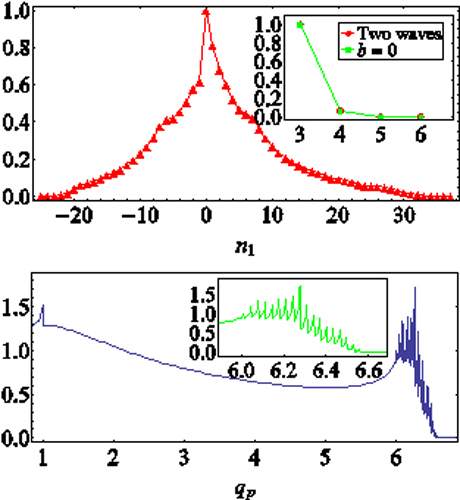
Upper panel: normalized pair-production probability for the process with the given number of photon absorbed from (emitted into) the low-frequency wave and one photon absorbed from the high-frequency wave, the inset shows the case when the high-frequency wave is absent. Lower panel: spectra of created pairs.
ICRANet-ի հետազոտողները մասնակցեցին "SWIFT 10 տարվա հայտնագործությունները" գիտաժողովին
Տասներորդ "Swift" հանդիպման ընթացքում (Հռոմի "La Sapienza" համալսարանում, Դեկտեմբերի 2-5, 2014թ.) Պրոֆ. Ռուֆֆինին ներկայացրեց զեկույց "The induced gravitational collapse model vs. the fireball collapsar model" թեմայով (Power Point-ը կարող եք գտնել այստեղ՝ http://www.icranet.org/documents/Swift10.pdf) և "ICRANet"-ի 7 ուսանողներ ներկայացրեցին պաստառները:
Զելդովիչի 100-ամյակին նվիրված գիտաժողովի նյութեր
ICRANet-ի վերջին հաջողությունները Ռիոյում
1) BSDC - 1WHSP: ՏէՎ էներգիայի տիրույթում ճառագայթող բլազարների ամենամեծ կատալոգը
Կազմվել է 996 HSP բլազարների կատալոգը (ակտիվ գալակտիկական միջուկների ամենաէքստրեմալ տեսակ), որը հանդիսանում է Բրունո Արսիոլիի ասպիրանտական ատենախոսության մի մասը: Հետազոտությունն իրականացվել է "ASDC"-ում, "ICRANet"-ի և Իտալիայի տիեզերական գործակալության համագործակցության շրջանակներում:
HSP բլազարները հատկապես հետաքրքիր են, քանի որ այդ արտագալակտիկական աղբյուրներում մասնիկներն արագանում են մինչև ամենաբարձր էներգիաներ և ճառագայթում են ֆոտոններ մինչև ՏէՎ էներգիաների տիրույթը: Կատալոգում ներառված մի քանի աղբյուրները կարող են գրանցվել ժամանակակից Չերենկովյան դիտակների միջոցով, իսկ նրանցից շատերը կգրանցվեն ապագա “CTA” դիտակների միջոցով: Կատալոգի ինտերակտիվ տարբերակը հասանելի կլինի առցանց Brazilian Science Data Center (BSDC) (www.bsdc.org) և ASDC (www.asdc.asi.it) կայքերում:
2) BSDC - Սպիտակ թզուկների արդիական կատալոգի ինտերակտիվ տարբերակը առցանց հասանելի է BSDC-ում
Սպիտակ թզուկների արդիական կատալոգը հիմնված SDSS-DR10 տվյալների վրա, վերջերս հրատարակվել է Ս. Օ. Կեպլերի և կոլեգաների կողմից (2015, MNRAS, 446, 4078): Այս ցուցակը պատրաստվել է ASDC-ի աջակցությամբ, որտեղ մի շարք BL Lac աղբյուրներ, որոնք ցույց են տալիս Սպիտակ թզուկ աստղի նման օպտիկական սպեկտր, բայց նաև ունեն ռադիո ճառագայթում, հայտնաբերվել և հեռացվել են ASDC ծրագրային գործիքների միջոցով:
Կատալոգի ինտերակտիվ տարբերակը, որը հնարավորություն է տալիս ստանալ օպտիկական սպեկտրը, IR տվյալները և շատ ավելին, հասանելի է BSDC և ASDC վեբ կայքերում:
3) ICRANet-ի Ռիոյի խմբի անդամների համահեղինակած հոդվածներ
Գալիք կոնֆերանսներ
Գալիք կոնֆերանսներ
MG14 Գրանցման բացում

Ուրախությամբ հայտարարում ենք, որ արդեն կարող եք առցանց գրանցվել 14-րդ Մարսել Գրոսմանի անվան գիտաժողովին, որը տեղի կունենա Հռոմում՝ "La Sapienza" համալսարանում 2015թ.-ի հուլիսի 12-ից 18-ը: (http://www.icra.it/mg/mg14/registration.htm)
Վաղ գրանցման վճարը կազմում է € 350 մինչև մայիսի 25-ը, որից հետո վճարը կլինի € 400: Ուսանողների վճարը € 150 է ցանկացած ժամանակ («Ուսանողի կարգավիճակի մասին» սերտիֆիկատով): Նախնական պաստառն այստեղ` http://www.icra.it/mg/mg14/MG14_poster.pdf Նիստերի ելույթների համառոտ տարբերակները պետք է ներկայացվեն մինչև 2015թ.-ի հունիսի 1-ը, բայց ցանկալի է, որպեսզի ներկայացվեն գրանցման ժամանակ: Մասնակիցների և զուգահեռ նիստերի կազմակերպիչների նախնական ցուցակը կարելի է գտնել այստեղ` http://www.icra.it/mg/mg14/par_sessions_chairs.htm Հրավիրված մասնակիցների նախնական ցուցակը հասանելի է այստեղ` http://www.icra.it/mg/mg14/invited_speakers.htm Բոլոր հարցերը կարող եք ուղարկել գիտաժողովի փոստարկղ` mg14@icra.it
"ICRANet’-ի երկրորդ "César Lattes" գիտաժողով

Գիտաժողովը նվիրված է Բրազիլիայում “ICRANet”-ի գիտական գործունեությանը և Էյնշտեյնի հավասարումների 100-րդ տարելիցին: Այս գիտաժողովը տեղի կունենա Uff և CBPF-ում, որը նախորդում է 2015թ.-ի հուլիսին Հռոմում կայանալիք MGXIV գիտաժողովին: “Public lectures” կներկայացվեն Ժամանակակից արվեստի թանգարանում (Museum of Contemporary Art (MAC), Cassino da URCA-ում, UFPE-ում, UFPB-ում և IFCE-ում:
Գիտաժողովի ընթացքում կքննարկվեն ռենտգենյան և գամմա ճառագայթման և UHECR-ի ստացված տվյալները, ինչպես նաև Նեյտրոնային աստղերի, Սև խոռոչների, Գրավիտացիոն ալիքների և կոսմոլոգիայի բնագավառում տեսական հաջողությունները: Նաև կքննարկվի Brazilian Science Data Center-ի (BSDC) գործունեություն մասին, որը ներառում է գալակտիկական և արտագալակտիկական աղբյուրներ: Կներկայացվեն նաև “ICRANet”-ի ծրագրերի կարգավիճակը և հեռանկարները “IRAP PhD” և “EMJD” ծրագրերի շրջանակներում, ինչպես նաև անդամ Post Doc և ավագ գիտաշխատղների ակտիվությունը: Արդեն կարող եք գրանցվել հետևյալ կայքում՝ http://www.icranet.org/2cl/registration.htm Գիտաժողովի կայքն է՝ http://www.icranet.org/2cl/ Նախնական պաստառը կարող եք ներբեռնել այստեղ՝ http://www.icranet.org/2cl/img/poster.pdf
Չորրորդ Galileo-Xu GuangQi անվան գիտաժողով

"International Conference on Gravitation and Cosmology"- չորրորդ Galileo-Xu GuangQi գիտաժողովը կազմակերպվելու է նշելու Իտալիայի և Չինաստանի գիտնականների միջև ուժեղ կապերը: Խորհրդանիշներն են Galileo Galilei (1564-1642) և Xu GuangQi (1562-1633)՝ Matteo Maria Ricci-ի (1552-1610) ընկերն ու հետևորդը, ով առավել քան որևէ մեկն օգնել է Եվրոպական նոր գիտական բացահայտումները բերել Չինաստան: Գիտաժողովը տեղի կունենա Պեկինում, 2015թ.-ի մայիսի 4-8: Նախորդ հանդիպումները տեղի են ունեցել Շանհայում 2009թ.-ին, 2010թ.-ին տեղի է ունեցել Nice/Ventimiglia-ում և 2011թ.-ին Պեկինում: Գիտաժողովը կառանձնանա բազմաթիվ արևմտյան գիտնականների և Չինաստանում խոշոր գիտական և ակադեմիական հաստատությունների մասնակցությամբ:
|
|
||
